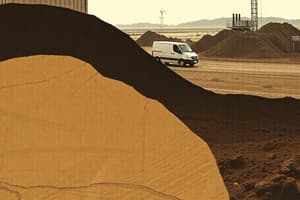Podcast
Questions and Answers
What undesirable outcome may occur if soil compaction is not performed properly during construction?
What undesirable outcome may occur if soil compaction is not performed properly during construction?
- Decreased permeability of the soil
- Increased shear strength of the soil
- Improved bearing capacity of the soil
- Settlement of the soil, leading to maintenance costs or structure failure (correct)
What does a lower value of relative density in soils indicate?
What does a lower value of relative density in soils indicate?
- A stable, well-compacted soil
- A loose and relatively unstable soil (correct)
- A soil at its optimum moisture content
- A soil with high shear strength
What is the significance of 'optimum moisture content' in the context of soil compaction?
What is the significance of 'optimum moisture content' in the context of soil compaction?
- The moisture content that results in the highest permeability
- The moisture content at which the soil is completely saturated
- The moisture content at which the soil has the lowest density
- The moisture content at which the maximum dry unit weight is attained (correct)
Which of the following is a common laboratory test used to assess soil compaction characteristics?
Which of the following is a common laboratory test used to assess soil compaction characteristics?
In the Standard Proctor Test, what is the weight and falling height of the hammer used for compaction?
In the Standard Proctor Test, what is the weight and falling height of the hammer used for compaction?
How does the Modified Proctor Test differ from the Standard Proctor Test in terms of compaction effort?
How does the Modified Proctor Test differ from the Standard Proctor Test in terms of compaction effort?
In soil compaction, what parameters are used to determine the moist unit weight?
In soil compaction, what parameters are used to determine the moist unit weight?
What parameters are required to determine the dry unit weight of compaction?
What parameters are required to determine the dry unit weight of compaction?
Which formula is used to calculate the Zero-Air-Void Unit Weight?
Which formula is used to calculate the Zero-Air-Void Unit Weight?
In the Sand Cone Method, what material is the jar filled with?
In the Sand Cone Method, what material is the jar filled with?
What is the purpose of using a rubber balloon in the Rubber Balloon Method for field density determination?
What is the purpose of using a rubber balloon in the Rubber Balloon Method for field density determination?
What does a nuclear density meter measure to determine the compacted dry unit weight of soil?
What does a nuclear density meter measure to determine the compacted dry unit weight of soil?
What is the formula for Relative Compaction (RC)?
What is the formula for Relative Compaction (RC)?
What is a key characteristic of Smooth Wheel Rollers in the context of field compaction equipment?
What is a key characteristic of Smooth Wheel Rollers in the context of field compaction equipment?
What approximate percentage of coverage is typically achieved by a Rubber Tire Roller?
What approximate percentage of coverage is typically achieved by a Rubber Tire Roller?
What type of soil is a Sheepsfoot Roller best suited for?
What type of soil is a Sheepsfoot Roller best suited for?
Which type of roller is similar to a sheepsfoot roller but provides approximately 40% coverage and is best for compacting fine-grained soils?
Which type of roller is similar to a sheepsfoot roller but provides approximately 40% coverage and is best for compacting fine-grained soils?
What is the ideal soil type for a Grid Roller?
What is the ideal soil type for a Grid Roller?
What is the typical pressure range of a Baby Roller?
What is the typical pressure range of a Baby Roller?
What is the application of a vibrating plate in field compaction?
What is the application of a vibrating plate in field compaction?
Which of the following factors is considered a characteristic of compaction equipment that affects soil compaction?
Which of the following factors is considered a characteristic of compaction equipment that affects soil compaction?
What is the role of 'layer thickness' in the compaction procedure?
What is the role of 'layer thickness' in the compaction procedure?
What is the primary function of 'vibration' as a special compaction technique?
What is the primary function of 'vibration' as a special compaction technique?
In dynamic compaction, what range does the weight of the hammer typically vary from?
In dynamic compaction, what range does the weight of the hammer typically vary from?
What is the process of Blasting used for in the context of soil compaction?
What is the process of Blasting used for in the context of soil compaction?
What is the typical range for the lateral spacing of explosive charges in Blasting for soil compaction?
What is the typical range for the lateral spacing of explosive charges in Blasting for soil compaction?
Which of the following is a purpose of soil compaction?
Which of the following is a purpose of soil compaction?
What is the typical number of layers used in a standard proctor test?
What is the typical number of layers used in a standard proctor test?
What standard is AASHTO T 99 related to?
What standard is AASHTO T 99 related to?
What is the compaction effort in the standard proctor test?
What is the compaction effort in the standard proctor test?
What is the hammer weight in the Modified Proctor Test?
What is the hammer weight in the Modified Proctor Test?
How many layers are used in the Modified Proctor Test?
How many layers are used in the Modified Proctor Test?
What is the designation for the Rubber Balloon Method?
What is the designation for the Rubber Balloon Method?
What is the area coverage of the Sheepsfoot Roller?
What is the area coverage of the Sheepsfoot Roller?
What approximate percentage of coverage is typically achieved by a Tamping Foot Roller?
What approximate percentage of coverage is typically achieved by a Tamping Foot Roller?
What is the area coverage of the Grid Roller?
What is the area coverage of the Grid Roller?
A vibrating plate is sometimes called "stamper" in?
A vibrating plate is sometimes called "stamper" in?
Flashcards
Soil Compaction
Soil Compaction
The method of mechanically increasing the density of soil, crucial in construction.
Purpose of Soil Compaction
Purpose of Soil Compaction
Soil compaction improves shear strength and bearing capacity, and stabilizes slopes.
Relative Density
Relative Density
Indicates the compactness of in-situ soils or compacted fills.
Optimum Moisture Content
Optimum Moisture Content
Signup and view all the flashcards
Standard Proctor Test
Standard Proctor Test
Signup and view all the flashcards
Modified Proctor Test
Modified Proctor Test
Signup and view all the flashcards
Sand Cone Method
Sand Cone Method
Signup and view all the flashcards
Rubber Balloon Method
Rubber Balloon Method
Signup and view all the flashcards
Nuclear Method
Nuclear Method
Signup and view all the flashcards
Moist Unit Weight
Moist Unit Weight
Signup and view all the flashcards
Dry Unit Weight
Dry Unit Weight
Signup and view all the flashcards
Zero-Air-Void Unit Weight
Zero-Air-Void Unit Weight
Signup and view all the flashcards
Relative Compaction
Relative Compaction
Signup and view all the flashcards
Smooth Wheel Roller
Smooth Wheel Roller
Signup and view all the flashcards
Rubber Tire Roller
Rubber Tire Roller
Signup and view all the flashcards
Sheepsfoot Roller
Sheepsfoot Roller
Signup and view all the flashcards
Tamping Foot Roller
Tamping Foot Roller
Signup and view all the flashcards
Grid Roller
Grid Roller
Signup and view all the flashcards
Baby Roller
Baby Roller
Signup and view all the flashcards
Vibrating Plate
Vibrating Plate
Signup and view all the flashcards
Vibration (Soil Compaction)
Vibration (Soil Compaction)
Signup and view all the flashcards
Dynamic Compaction
Dynamic Compaction
Signup and view all the flashcards
Blasting (Soil Compaction)
Blasting (Soil Compaction)
Signup and view all the flashcards
Weight and Size
Weight and Size
Signup and view all the flashcards
Initial Density
Initial Density
Signup and view all the flashcards
Soil Type
Soil Type
Signup and view all the flashcards
Number of Passes
Number of Passes
Signup and view all the flashcards
Study Notes
Soil Compaction
- Soil compaction is a method used to mechanically increase the density of soil.
- It's an important part of the building process in construction.
- Settlement of the soil could occur if not performed properly, resulting in structure failure and costly maintenance.
Purpose of Soil Compaction
- Improves soil quality by increasing shear strength and bearing capacity.
- Decreases future settlements and permeability.
- Increases the stability of slopes for embankments.
Relative Density
- Relative density indicates the degree of compactness of in-situ soils and compacted fills.
- Loose soil is indicated by a lower relative density value and is relatively unstable.
- More stable soils have a higher relative density value.
- Optimum Moisture Content is the moisture content at which the maximum dry unit weight is obtained.
Equations for Relative Density
- Dr = (emax - e0) / (emax - emin) x 100%
- emax = void ratio of the soil in its loosest condition
- emin = void ratio of the soil in its densest condition
- e0 = in-situ void ratio
- Dr = (γmax(γ - γmin)) / (γ(γmax - γmin)) x 100%
- γ = in-situ dry unit weight
- γmax = maximum dry unit weight
- γmin = minimum dry unit weight
- Dr = relative density
Soil Compaction Tests
- Laboratory tests include the Standard Proctor Test and the Modified Proctor Test.
- Field tests include the Sand Cone Method, Rubber Balloon Method, and Nuclear Method.
Standard Proctor Test
- The soil is compacted within a cylindrical tube.
- Equipment specifications include:
- Hammer weight = 2.5 kg (5.5 lb)
- Falling height = 1 ft
- Amount of layers = 3
- Number of blows per layer = 25
- Compaction effort = 592.5 kJ/m³
- Soil type = passes through sieve no. 4
- The test is performed several times with different water contents.
- After compaction, the weight, moisture content, and unit weight of samples are measured.
- Test standards are AASHTO T 99 and ASTM D698.
Modified Proctor Test
- The soil is compacted within a cylindrical tube.
- Specifications include:
- Hammer weight = 4.5 kg (10 lb)
- Falling height = 1.5 ft
- Amount of layers = 5
- Number of blows per layer = 25, 56
- Compaction effort = 2693 kJ/m³
- Soil type = passes sieve no. 4
- The test is performed multiple times with varying water content.
- Weight, moisture content, and unit weight of samples are measured after compaction.
- Test standards include AASHTO T 180 and ASTM D1557.
Parameters for Soil Compaction
- Moist Unit Weight of Compaction is calculated as γ = W / V(m)
- γ = moist unit weight
- W = weight of compacted soil in the mold
- V(m) = volume of mold (1/30 cu.ft)
- Dry Unit Weight of Compaction
- γdry = γ / (1 + (ω(%)/100))
- γdry = (Gsγw) / (1 + (ω/Gs))
- γ = moist unit weight
- γdry = dry unit weight
- ω = moisture content in percent
- Gs = specific gravity
- S = degrees of saturation
- Zero-Air-Void Unit Weight is calculated as γzav = (Gsγw) / (1 + ωGs) or γzav = γw / (ω + (1/Gs))
- γzav = zero air void unit weight
- γw = unit weight if water
- ω = moisture content in percent
- Gs = specific gravity
Sand Cone Method (Field Test)
- ASTM Designation D – 1556 dictates the method.
- A device consisting of a glass or plastic jar with a metal cone is used. The jar is filled with Ottawa sand.
Sand Cone Method Procedure
- W1 = the weight of the jar, cone, and sand filling
- W2 = weight of the moist soil excavated from the hole
- W3 = dry unit weight of the soil
- calculated as W3 = W2 / (1 + (ω(%)/100))
- W4 = combined weight of the jar, cone, and remaining sand in the jar.
- W5 = weight of sand to fill the hole and cone
- calculated as W5 = W1-W4
- V = volume of the hole
- calculated as V = (W5 – Wc) / γd (sand)
- γd = Dry weight of the soil excavated from the soil / Volume of the hole
- calculated as γd = W3 / V
Rubber Balloon Method (Field Test)
- ASTM Designation D – 2167 is the standard.
- The moist weight of soil removed from a test hole and its moisture content are determined.
- Volume of the hole is determined by introducing a rubber balloon filled with water from a calibrated vessel.
Nuclear Method (Field Test)
- Density meters are used to determine the compacted dry unit weight of soil.
- Density meters operate in drilled holes or on the ground surface.
- The instrument measures the weight of wet soil per unit volume as well as the weight of water.
Specification of Compaction: Relative Compaction
- Relative Compaction is an end product specification calculated as RC = (γd(field) / γd(max)-lab) x 100%
Types of Field Compaction Equipment
- Smooth Wheel Roller: supplies 100% coverage, ground contact pressures up to 400 kPa, used on all soil types except rocky soils, and mainly for proof rolling subgrades and compacting asphalt pavements.
- Rubber Tire Roller: heavily loaded wagon with rows of tires (3-6), tire pressure up to 700 kPa, 80% coverage, and used for granular and cohesive highway fills.
- Sheepsfoot Roller: round or rectangular protrusions ("feet") attached to a steel drum, protusion area ranges from 30 - 80 cm2, 8-12% coverage, very high contact pressures from 1400 to 7000 kPa, best suited for cohesive soils.
- Tamping Foot Roller: similar to sheepsfoot roller, approximately 40% coverage, pressures between 1400-8400 kPa, and best for compacting fine-grained soils.
- Grid Roller: about 50% coverage, pressures between 1400-6200 kPa, best suited for compacting rocky soils, gravels, and sand.
- Baby Roller: small type of smooth wheel roller with pressures from 10 to 30 kPa with performance based on weight and effect from vibration.
- Vibrating Plate: plate shaped compaction equipment sometimes called a “stamper”, used in narrow and high-risk areas where use is needed.
Conditioner Factors
- Characteristics of compaction equipment such as weight, size, operation frequency, and its proper range.
- Soil characteristics like initial density, soil type, size and shape of soil particles, and moisture content.
- Compaction procedure: number of roller passes, layer thickness, frequency of operation of vibrator, and towing speed.
Special Compaction Techniques
- Vibration: in-situ densification of loose granular soil deposits using a vibroflot (vibrating unit) with an eccentric weight inside for centrifugal force.
- Dynamic Compaction: repeated dropping of heavy weight objects on the ground at regular intervals; hammer weight varies from 80 to 356 kN, hammer drop height varies from 7.5 to 30.5m; the degree of compaction achieved depends on the weight of the hammer, height of hammer drop, and spacing of locations at which the hammer is dropped.
- Blasting: detonation of explosive charges (dynamite) at a certain depth, lateral spacing of charges ranges from 3 to 9m, charges are placed at 2/3 depth of soil layer for compaction, and three to five successful detonations are necessary.
Studying That Suits You
Use AI to generate personalized quizzes and flashcards to suit your learning preferences.




